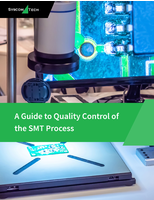VXS Computing Module suits radar, SIGINT/EW applications.
Press Release Summary:
Part of Ensemble(TM) 5000 Series, embedded HCD5220 enables accelerated access to information from distributed sensors via Converged Sensor Network(TM) Architecture. It combines 2 Freescale(TM) 8641D PowerPC processors with dual PMC/XMC mezzanine sites, optimizing balance of I/O and processing per slot. Thermal design supports 1.33 GHz processor in 0.8 in. VXS slot. In addition to 3.125 Gbaud Serial RapidIO switch topology, each PowerPC processor is paired with internal/external GbE interfaces.
Original Press Release:
Mercury Computer Systems Announces Availability of Ensemble 5000 Series VXS Embedded Computing Module for Radar, SIGINT/EW, and Industrial Applications
New, powerful product family to provide enhanced protection for software algorithm investment, multi-platform code portability, and rapid deployment on multiple form factors
Initial offering combines multicore Freescale processors with advanced switched-fabric topologies to enable 2x increase in SWaP performance for image and signal processing
CHELMSFORD, Mass., April 29 -- Mercury Computer Systems, Inc. (NASDAQ:MRCY), a leading provider of embedded, high-performance computing solutions for image, sensor, and signal processing applications, announced availability of the Ensemble(TM) 5000 Series VXS HCD5220 Dual 8641D Dual-Core Processing Module. The HCD5220 is the first of several new products from the VXS Ensemble 5000 Series product family designed to extend embedded, high-performance computing to a sensor-networked environment, enabling rapid access to critical information from distributed sensors via the Converged Sensor Network(TM) (CSN(TM)) Architecture.
The Ensemble VXS HCD5220 is rich with architectural innovations and industry firsts. The HCD5220 combines the high-performance computing power of two Freescale(TM) 8641D PowerPC processors with dual PMC/XMC mezzanine sites, creating the ultimate balance of I/O and processing per slot. For example, signals intelligence/electronic warfare (SIGINT/EW) applications are typically optimized for size, weight, and power (SWaP) constraints. The HCD5220, when configured with the industry-leading Echotek(R) Series Digital Receiver modules, allows up to eight channels of processing per HCD5220, doubling the channel count per slot compared to previously available systems. Additionally, the innovative thermal design of the HCD5220 supports the faster 1.33 GHz 8641D processor in a standard 0.8" inch VXS slot. These improvements result in an overall 2x increase in performance relative to currently available SIGINT/EW processor-digital receiver subsystems.
For SAR/MTI (synthetic aperture radar/moving target indicator) radar applications, the HCD5220 brings new heights to system-level processing performance while simultaneously simplifying application development. Scaling a chassis to 18 HCD5220 modules and two Serial RapidIO(R) switch modules, the system offers two to three times more bisection bandwidth than mesh topologies of similar sizes, such as Mercury's previous generation of VPX products. For large systems, this increase in bisection bandwidth enables new and faster radar algorithm processing, as well as reduced system size, weight, and cost.
"While a number of embedded computing suppliers, including Mercury, are aggressively working to improve system-level capabilities in VPX, Mercury's VXS processor-based designs leverage those capabilities today. We created the Ensemble 5000 Series for new VXS designs in radar, SIGINT/EW, and industrial control, as well as for customers looking for development platforms for future VPX switch-enabled systems," said Steve Patterson, Product Group Manager for 6U VPX and VXS Systems at Mercury Computer Systems. "Unlike mesh-based designs, switch-based topologies simplify the customer's system design by making the application independent of the slot location in the chassis, while simultaneously providing 2x to 3x improvement in key system performance parameters."
As the first of several products in development for the VXS Ensemble 5000 Series, the HCD5220 includes key architectural elements from Mercury's CSN Architecture. Each PowerPC processor in a large multi-board system is paired with several internal and external Gigabit Ethernet interfaces, allowing any processor to communicate with any other processor for system control, as well as with customer-configured external networked resources. The Ethernet network is in addition to the 3.125 Gbaud Serial RapidIO switch topology for application data. Future offerings in the VXS Ensemble 5000 family under the CSN umbrella are planned to include a 10 Gigabit Ethernet real-time gateway for system connection with external Ethernet backbones, similar to Mercury's SR-110 10GE VXS Gateway module in production today.
Ensemble Series software enables rapid deployment of customer applications across 3U VPX, 6U VPX, and VXS form factors. Moreover, with identical hardware building blocks, the Ensemble products share identical Linux(R) and VxWorks(R) development and runtime environments. Customer applications for the HDC5220 can be easily retargeted for other Ensemble products. This allows users to have a single software code base, a protected investment in software algorithms, code portability, performance predictability, and rapid deployment across multiple form factors.
The VXS HCD5220 module is available now. For systems with low power requirements, the HCD5220 is available with the 1.06 GHz 8640D processor, a lower-power version providing the identical PowerPC processing architecture. Entry-level versions in volume start at under US$10,000. For more information on the Ensemble 5000 Series VXS HCD5220 Module, visit www.mc.com/ES, or contact Mercury at (866) 627-6951 or info@mc.com.
Mercury Computer Systems, Inc. -- Where Challenges Drive Innovation(TM)
Mercury Computer Systems (www.mc.com, NASDAQ: MRCY) provides embedded computing systems and software that combine image, signal, and sensor processing with information management for data-intensive applications. With deep expertise in optimizing algorithms and software and in leveraging industry-standard technologies, we work closely with customers to architect comprehensive, purpose-built solutions that capture, process, and present data for defense electronics, homeland security, and other computationally challenging commercial markets. Our dedication to performance excellence and collaborative innovation continues a 25-year history in enabling customers to gain the competitive advantage they need to stay at the forefront of the markets they serve.
Mercury is based in Chelmsford, Massachusetts, and serves customers worldwide through a broad network of direct sales offices, subsidiaries, and distributors.
Challenges Drive Innovation, Converged Sensor Network, CSN, and Ensemble are trademarks, and Echotek is a registered trademark of Mercury Computer Systems, Inc. Other product and company names mentioned may be trademarks and/or registered trademarks of their respective holders.




